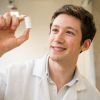
Dr Alastair Marsh
- Course: Civil engineering materials - postdoctoral research
- PhD title: Alkali activated earth construction materials PhD
- Year of graduation: 2018
- Job title: Research Fellow in alkali-activated materials
- Company: University of Leeds
Dr Alastair Marsh is a postdoctoral researcher in the School of Civil Engineering, working with Professor Susan Bernal Lopez to conduct research in civil engineering materials. Before joining the University of Leeds, Alastair undertook PhD research at the University of Bath within architecture and civil engineering.
Low carbon infrastructure – a new toolkit
The type of cement that is widely used to bind concrete currently accounts for 8% of global CO2 emissions. Alastair is working alongside Professor Susan Bernal a team of researchers to investigate a more sustainable alternative using low carbon materials.
He said: “Our research ambition is to design the cements and concretes of the future that will provide safe, robust and low carbon infrastructure and housing for our world’s growing population.
“I chose to do research on construction materials, as I wanted a way to combine two of my passions: the excitement of doing ‘detective work’ to understand how materials behave, and the mission to give everyone in the world the best chance of a happy and fulfilling life.
“This may not seem immediately relevant to bricks and concrete at first sight - but our ability to provide safe, affordable, comfortable housing for the world’s growing global community is one of the biggest challenges of this century.”
Our ability to provide safe, affordable, comfortable housing for the world’s growing global community is one of the biggest challenges of this century.
He continued: “Crucially, it’s a challenge where materials science and engineering has a key role to play.
“Concrete gets a lot of criticism for its global carbon emissions footprint. It’s true that it’s a big emitter, but the reality is that our society will continue to rely on concrete for our transport, energy and housing. We basically can’t live without it.
“In our research group, we believe the best approach is change from within: that by developing a ‘toolkit’ of different cements and concretes for different places and applications, we can use concrete more effectively - as well as reducing its overall environmental impacts.”
By developing a ‘toolkit’ of different cements and concretes... we can use concrete more effectively - as well as reducing its overall environmental impacts.”
Expertise in alternative cements
Alastair’s research at Leeds is seeking to answer the question of how we can overcome the practical barriers in manufacturing one type of alternative cement, ‘alkali-activated cement’.
He said: “Our research group’s leader, Professor Bernal Lopez, is a world expert in alternative cements: designing new mixes, understanding the chemical reactions underlying how they behave, and testing their performance in different conditions.”
“By manipulating the composition of the cement powder and the chemical reactions that occur when it’s mixed with water, we hope that it can become just as user-friendly as conventional cements,” Alastair added.
My research project is one piece of the puzzle that our research group is trying to solve: how we can make the range of new cements and concretes which our society urgently needs.
Life as a postdoctoral researcher
Working in a research department includes a variety of roles and responsibilities on a day-to-day basis, and there are advantages in being able to work flexibly.
Alastair said: “My time is mostly a combination of running experiments in the laboratory, analysing data, planning new experiments, writing articles and funding applications, and assisting with the smooth running of our research group.
“There’s fairly regular trips to conferences, project meetings at other universities and training courses too. I also spend a lot of time just, well, thinking – be it at my desk, walking to campus or even swimming.”
He added: “I am fortunate that the funding on my research project is quite flexible, so I try to really focus on how I can work out the best answers to the most important questions.”
Excellent facilities
The University of Leeds, along with its bustling community of researchers from different disciplines, has state-of-the-art facilities which will include the new UKCRIC National Centre for Infrastructure Materials and Bragg Centre for Materials Research.
“The reputation of the School of Civil Engineering for high quality research and the fantastic facilities at Leeds were both big pull factors for me to join,” Alastair said.
...the range of instruments we have for characterising materials make it a scientist’s playground.”
“For working on new construction materials, it’s a dream come true – the range of instruments we have for characterising materials make it a scientist’s playground.”
Sharing knowledge
Leeds has a strong interdisciplinary culture, making it an excellent place to share expertise for the advancement of research projects and professional development. Alastair talked about how the University’s research community has enhanced his career.
He said: “My timing was very fortunate – I joined a new research group in Leeds that is now growing very quickly.
“Helping to build our group has been a great experience so far: setting up our new lab facilities; guiding our new group members to settle in, and having insights into recruitment, funding applications and research strategy.
Alastair added: “This will be very valuable experience if one day I have the opportunity to start my own research group.”

